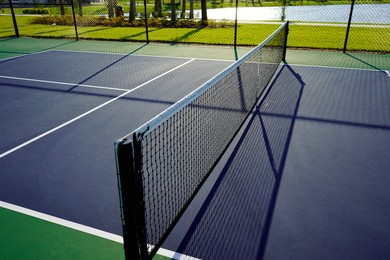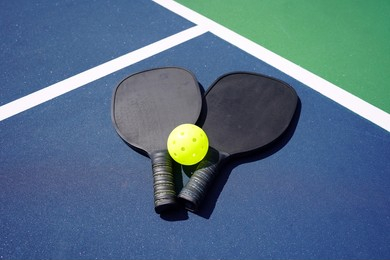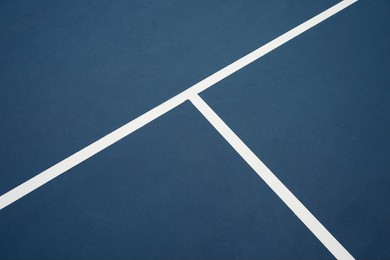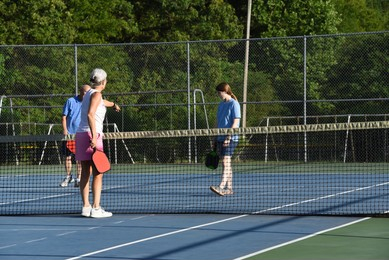Discover the ideal dimensions for a pickleball court and learn everything you need to know about the space requirements for this exciting sport.
Pickleball has gained immense popularity in recent years, attracting players of all ages and skill levels.
In this comprehensive guide, I will explore the ideal dimensions for a pickleball court, discuss the importance of space, and provide answers to some common questions. Let’s dive in!
What are the Pickleball Court dimensions?

A standard pickleball court measures 20 feet wide and 44 feet long. It is slightly smaller than a traditional tennis court, making it more suitable for pickleball’s fast-paced and dynamic gameplay.
These dimensions are set by the International Federation of Pickleball (IFP), the governing body for the sport, to ensure consistency and fairness in tournament play.
The court is divided into several sections, each serving a specific purpose. Let’s break down the different areas and their dimensions:
- Baseline: The baseline is the boundary line at the back of the court. It extends the full width of the court, measuring 20 feet.
- Sidelines: The sidelines run parallel to the net and mark the width of the court. They measure 44 feet in length.
- Non-Volley Zone: The non-volley zone, often referred to as the “kitchen,” is a special area in front of the net. It extends 7 feet from the net on both sides, creating a 14-foot-wide zone. This zone is critical to gameplay, as players are not allowed to hit volleys (shots hit in the air without a bounce) while standing inside it.
- Service Areas: There are two service areas on each side of the net, measuring 10 feet by 15 feet each. These rectangles indicate where the server must stand while serving. The server must keep both feet behind the baseline and within the service area during the serve.
How much space do you need for a Pickleball Court?
A pickleball court is slightly smaller than a traditional tennis court, but it still requires a sufficient amount of space to ensure fair gameplay and player safety.
The dimensions of a standard pickleball court are 20 feet wide and 44 feet long, providing ample room for rallies and strategic shots. The court is divided into different areas mentioned above, each serving a specific purpose.
How to Build an Outdoor Pickleball Court?

If you’re an avid pickleball player and want to enjoy the game right in your own backyard, building an outdoor pickleball court is a fantastic idea. In this section, we’ll provide you with a step-by-step guide on how to build your very own pickleball court. Let’s get started!
Determine the Available Space
Measure the area where you plan to build the pickleball court. A standard pickleball court requires a minimum area of 30 feet by 60 feet.
However, if space is limited, you can adjust the dimensions while maintaining the proper ratios between the different sections of the court. Ensure the playing area is flat and free from any obstacles or obstructions.
Gather Materials and Equipment
To build a pickleball court, you’ll need the following materials and equipment:
- Boundary markers (tape, paint, or chalk)
- Pickleball net and posts
- Measuring tape
- Shovel
- Leveling equipment (laser level or string level)
- Gravel or crushed stone
- Outdoor sports surface material (asphalt, concrete, or synthetic surface)
Mark the Court Boundaries
Using the boundary markers of your choice, mark the outer boundaries of the court. Start with the baseline, which should be 20 feet wide, and then mark the sidelines, which should be 44 feet long. Ensure the lines are straight and properly aligned.
Excavate and Level the Area
Using a shovel, excavate the playing area to a depth of about 4 inches to 6 inches. Remove any grass, rocks, or debris from the area. Once the area is excavated, use leveling equipment (a laser level or string level) to ensure the playing surface is flat and even.
Choose the Surface Material
Decide on the surface material for your pickleball court. There are several options available, including asphalt, concrete, or synthetic surfaces. Each material has its own advantages and considerations. Research the pros and cons of each option and choose the one that best suits your preferences and budget.
Install the Surface Material
If you’ve chosen an asphalt or concrete surface, hire a professional contractor to install it. They will ensure proper preparation and installation, including leveling, compacting, and applying the appropriate coatings.
For a synthetic surface, follow the manufacturer’s instructions for installation. This may involve laying down a base layer, attaching the surface material, and securing it in place.
Install the Pickleball Net and Posts
Once the surface material is ready, it’s time to install the pickleball net and posts. Follow the manufacturer’s instructions to set up the net and ensure it is at the proper height and tension. The net should be placed in the center of the court, with the posts securely anchored.
Finishing Touches
Inspect the court for any imperfections or uneven areas. Make necessary adjustments and ensure the court is in optimal condition for play. Consider adding additional amenities, such as seating or shading, to enhance the playing experience.
Congratulations! You’ve successfully built your outdoor pickleball court. Now it’s time to invite friends, family, and fellow pickleball enthusiasts to enjoy the game in the comfort of your own backyard.
Equipment to Play Pickleball

In this section, we’ll discuss the essential gear you’ll need to get started. Let’s dive in!
1. Pickleball Paddle
The pickleball paddle is a key piece of equipment used to hit the ball. It resembles a large table tennis paddle but is slightly larger and made of materials like wood, composite, or graphite. When choosing a paddle, consider factors such as weight, grip size, and material. Pick a paddle that suits your playing style and skill level.
2. Pickleball Balls
Pickleball balls are similar to wiffle balls, featuring distinctive patterns of holes that help reduce the ball’s speed. They come in different colors, with the most common being yellow. Pickleball balls are available in indoor and outdoor varieties. Outdoor balls are more durable and have thicker walls to withstand rough surfaces.
3. Pickleball Net
A pickleball net is an essential component of the court set up. The net should be placed in the center of the court, dividing it into two halves. It typically measures 36 inches in height at the center and 34 inches at the sides. Ensure the net is securely attached to posts or supports and is at the appropriate tension for gameplay.
4. Court Shoes
Proper court shoes are crucial for pickleball, as they provide stability, support, and traction on the playing surface. Look for shoes specifically designed for indoor or outdoor court use, depending on your preferred playing environment. Good court shoes should have non-marking soles to avoid leaving scuff marks on the court.
5. Appropriate Attire
Wear comfortable clothing that allows for ease of movement during gameplay. Opt for breathable, moisture-wicking fabrics that keep you cool and dry. While there are no strict dress codes for recreational play, it’s a good idea to wear clothing suitable for sports activities.
6. Protective Eyewear (Optional)
Although not mandatory, protective eyewear is recommended, especially for competitive play. Pickleball is a fast-paced game, and accidents can happen. Wearing protective eyewear can help prevent eye injuries caused by stray balls or collisions.
How large should Pickleball Out-of-Bounds Zones be?

According to the official rules of the International Federation of Pickleball (IFP), the out-of-bounds zones for indoor play should be a minimum of 6 feet (1.83 meters) from the sidelines and 10 feet (3.05 meters) from the back baseline. This means that any shot that lands beyond these designated areas will be considered out-of-bounds.
For outdoor play, the IFP recommends a minimum out-of-bounds zone of 7 feet (2.13 meters) from the sidelines and 10 feet (3.05 meters) from the back baseline.
It’s important to note that different organizations and tournaments may have their own specific rules regarding the size of out-of-bounds zones, so it’s always a good idea to check the rules of the specific event or venue you’ll be playing in to ensure compliance.
What are the Rules of Pickleball?

Here are the basic rules of pickleball:
Court and Equipment:
- Pickleball is played on a badminton-sized court, either indoors or outdoors.
- The court is divided into two halves by a net.
- The equipment includes a pickleball, which resembles a wiffle ball, and a paddle, which is larger than a ping pong paddle but smaller than a tennis racket.
Serving:
- The serve must be made underhand.
- The server must keep one foot behind the back baseline and hit the ball diagonally to the opponent’s service area.
- The serve must clear the net and land in the diagonal service court.
- The receiving team must let the serve bounce before returning it.
Scoring and Winning:
- Points are scored by the serving team only.
- If the serving team wins a rally, they score a point and the same server continues to serve from the alternate service court.
- If the receiving team wins a rally, they become the serving team, and the server switches sides.
- Games are typically played to 11 points, and the winning team must win by a margin of at least 2 points.
- Matches are usually the best of three games.
Volley Zone (Kitchen):
- The area near the net, within 7 feet on both sides, is called the volley zone or the kitchen.
- Players cannot volley (hit the ball in the air without it bouncing) while standing inside the kitchen unless the ball bounces there first.
Double Bounce Rule:
- After the serve, each team must let the ball bounce once before returning it.
- Once each team has had one bounce, volleys are allowed.
Faults:
- A fault occurs if the serve does not clear the net or lands out of bounds.
- Other faults include stepping into the non-volley zone during a volley, hitting the ball out of bounds, or volleying before the ball bounces in the kitchen.
How to Draw Temporary Pickleball Lines?
Following the measurement of your dimensions, you can draw your temporary pickleball lines in a variety of ways.
- Tape: Tape lines should be applied by stretching the tape from the base point to the endpoint. Apply it straight and evenly by gently pressing it down. Tape that is easily removable, such as painter’s tape, should be used.
- Chalk: If you’re using chalk, it’s much easier to draw your lines out as you’re measuring. So, you can trace along the measuring tape to get a straight, smooth line.
Generally, the lines must be 2 inches (5.08 cm) wide and the same color, in contrast to the playing surface’s color.
Related: What Are The Tennis Court Dimensions And Markings?
FAQs
What is the minimum size for a pickleball court?
The minimum size for a pickleball court is 20 feet wide by 44 feet long for both singles and doubles play. This size meets the requirements set by the USA Pickleball Association (USAPA) and is considered the standard size for pickleball courts.
How much extra space do you need around a pickleball court?
When it comes to the extra space needed around a pickleball court, it is recommended to have a minimum of 10 feet of clear space around the entire court. This allows players to move freely and retrieve balls without any obstructions. Having this extra space also helps ensure player safety and reduces the risk of collisions with surrounding objects or structures.
What are the dimensions of a full pickleball court?
The dimensions of a full pickleball court are as follows:
Width: 20 feet
Length: 44 feet
These dimensions are consistent for both singles and doubles play. The court is divided into equal halves by a net that is positioned at a height of 36 inches at the ends and 34 inches in the center. The court is also marked with various lines to indicate the boundaries and serving areas for different game situations.